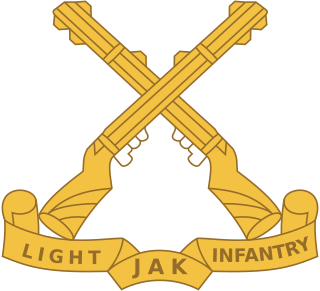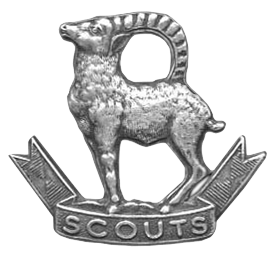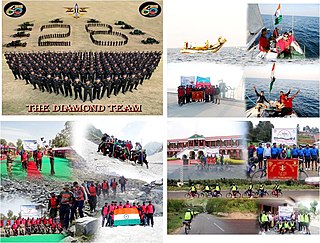
The Jammu and Kashmir Rifles is an infantry regiment of the Indian Army. Its origins lay in the Jammu and Kashmir State Forces of the princely state of Jammu and Kashmir. After the accession of the state to the Indian Union in October 1947, the State Forces came under the command of the Indian Army. They remained in the original form until 1956 when Jammu and Kashmir Constituent Assembly effectively ratified the state's accession to India. Then the State Forces became the Jammu and Kashmir Regiment of the Indian Army. In 1963, the designation was changed to Jammu and Kashmir Rifles. After the conversion, the Ladakh Scouts came under the aegis of the Regiment, where it remained until raised as a separate Regiment in 2002.

The 11 Gorkha Rifles is a Gorkha regiment of the Indian Army that was re-raised after independence. The regiment consists of primarily the Kirant Tribes Rai, Limbu, Yakkha, Sunuwar of Eastern Nepal, Darjeeling, Kalimpong, Dooars of West Bengal, Sikkim and other parts of Northeast India. Though it is considered to be the youngest of the Gorkha regiments its lineage is as long as those of the 7th Gurkha Rifles and 10th Gurkha Rifles.

The Brigade of The Guards is a mechanised infantry regiment of the Indian Army. It was raised as the first "all India", "all class" infantry unit of the Army where troops from all parts of India serve together, as opposed to other regiments that recruit from specific regions, ethnic groups or religions.

The Parachute Regiment is an airborne and special forces regiment of the Indian Army. It was raised in 1945 as part of the British Indian Army but was disbanded after World War II and was re-raised in 1952 as part of the Indian Army. Currently it consists of fifteen Special Forces, two Territorial Army and one Rashtriya Rifles battalions.

The Kumaon Regiment is one of the oldest infantry regiments of the Indian Army. The regiment traces its origins to the 18th century and has fought in every major campaign of the British Indian Army and the Indian Army, including the two world wars, and is one of the highest decorated regiments of the Indian Army.

The Madras Regiment is the oldest infantry regiment of the Indian Army, originating in the 1750s as a unit of the British East India Company. The regiment took part in numerous campaigns with the British Indian Army and the post-independence Indian Army.

The Jammu and Kashmir Light Infantry is an infantry regiment of the Indian Army. The regimental center is in Srinagar's Airport Complex at Awantipora with a winter setup near Jammu. Its regimental insignia consists of a pair of crossed rifles. The regiment mostly consists of volunteers from the state of Jammu & Kashmir and ethnic groups from the state. The Jammu and Kashmir Light Infantry is considered to be one of the most decorated regiment of the Indian army having won 1 Param Veer Chakra and 3 Ashok Chakra. Naib Subedar Chuni Lal of the 8th battalion Jammu and Kashmir Light Infantry is one of the most decorated personnel of the Indian Army.
The Sikh Light Infantry is a light infantry regiment of the Indian Army. The regiment is the successor unit to the 23rd, 32nd and 34th Royal Sikh Pioneers of the British Indian Army. The regiment recruits from the Sikh community of Himachal Pradesh, Punjab and Haryana states of India.

The Garhwal Rifles, formerly known as the Royal Garhwal Rifles, are an infantry regiment of the Indian Army. It was originally raised in 1887 as the 39th (Garhwal) Regiment of the Bengal Army. It then became part of the British Indian Army, and after the Independence of India, it was incorporated into the Indian Army.

The Nair Brigade was the army of the erstwhile kingdom of Travancore in India. Nairs were a warrior community of the region. The personal bodyguard of the king Marthanda Varma (1706–1758) was also called Thiruvithamkoor Nair Pattalam. The Travancore army was officially referred as the Travancore Nair Brigade in 1818.

The Ladakh Scouts is an infantry regiment of the Indian Army, nicknamed as the "Snow Warriors" or "Snow Leopards". The regiment specializes in mountain warfare, and its primary role is to guard India's borders in the high altitudes of the Union Territory of Ladakh.

The 54th Infantry Division is an Infantry division of the Indian Army. The Division was raised as an Infantry Division, but was converted into a Reorganised Amphibious Formation (RAMFOR) in 2011. It is currently the only division of the Indian Army which carries out Amphibious warfare. The division is headquartered at Secunderabad in Telangana and is a part of XXI Corps. The Division is commanded by an Officer of the rank of Major General titled General Officer Commanding (GOC).
156 Light Air Defence Missile Regiment (Self Propelled) is an Air Defence regiment of the Indian Army.
3 Medium Regiment is part of the Regiment of Artillery of the Indian Army.
79 Medium Regiment is part of the Regiment of Artillery of the Indian Army.
80 Medium Regiment is part of the Regiment of Artillery of the Indian Army.

28 Air Defence Regiment is part of the Corps of Army Air Defence of the Indian Army.
78 Field Regiment is part of the Regiment of Artillery of the Indian Army.
176 Medium Regiment is part of the Regiment of Artillery of the Indian Army.
75 Medium Regiment is part of the Regiment of Artillery of the Indian Army.













